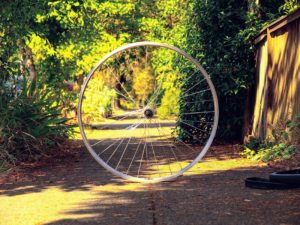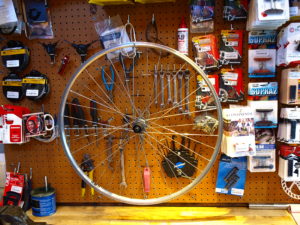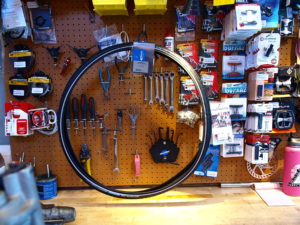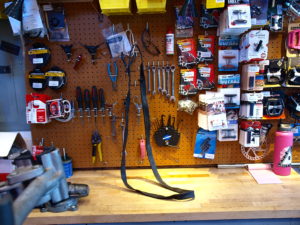Cyclists often underestimate the importance of wheel, tire and even tube selection in terms of overall ride performance. Of course racers think about this but many more casual users and daily commuters could benefit more than they might think from an upgrade in wheels, tires, and tubes. At Upcycles we love to sell, build, and maintain ALL kinds of bicycles but our main customer base in Portland, OR is always commuters so that’s the user group we’ll focus on. If you have different concerns or questions you can always give us a call or come by and chat.
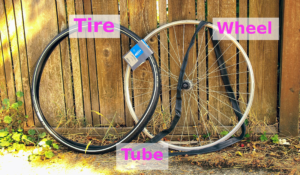 Many people use the terms “wheel”, “tire”, and “tube” interchangeably. It’s always helpful if you can accurately describe the issue you’re having to a bike mechanic using the correct terminology.
Many people use the terms “wheel”, “tire”, and “tube” interchangeably. It’s always helpful if you can accurately describe the issue you’re having to a bike mechanic using the correct terminology.
The Wheel is the main structure, all the metal, the rim, the spokes, and the hub (the very center part of the wheel that attaches to the bike).
The Tire is the black (usually) rubber part you see on the outside of the wheel, it’s the part that touches the ground.
The Tube is INSIDE the tire (between the tire and the rim) and it’s the part that holds the air in. The valve sticking out of the rim where you attach a pump is actually part of the tube sticking up through the rim.
Often when you get a flat “tire” you just need a new tube if your actual tire isn’t worn out, or you can patch the flat tube if the hole is small enough. But if you bring your bike to Upcycles we will put a whole new tube because they’re inexpensive and patches can fail and we want to keep you rolling.
Wheels: Bike commuters usually don’t bother “upgrading” their wheels for performance purposes but instead just get a slightly better wheel when one wears out. “Better” wheels can mean a lot of things. Lighter, stronger, smaller, larger, different materials, different technical specs. Your wheel size and type of brake (rim or disc) are determined by your bike generally (with some exceptions) so you’re pretty much stuck there. For most bike commuters you’re probably gonna want to focus on strength and durability. Then, if you can afford it, you might think about weight.
The old Bontrager mountain biking adage remains mostly true: “strong, light, cheap, pick two”. It’s usually a large jump in price to shave not that much weight off a wheelset. It makes sense to stretch the budget for racing but commuters who ride every day or close to it will probably do better with a slightly heavier wheel that will last a long time. It used to be you had to have quality wheels handbuilt for you. Nowadays there are MANY off the shelf high quality options available that are sturdy and won’t break the bank. Both mechanics at Upcycles have ridden wheels using the inexpensive yet tough NoBS rims from Velocity and found them so be a great budget option. We can order a variety of wheels if you need a more upgraded replacement or we can set you up with a whole new pair of “shoes” if your current wheelset is making you feel sluggish!
Disc brakes are also often marketed with an eye toward racers but they actually make a lot of sense for city riders especially here in Portland, Oregon where it rains more than half the time! Disc brakes are great for commuters because of their strong stopping power even when wet or muddy, longer stretches between pad changes, and the fact that you’re not wearing your rim out every time you brake leading to longer wheel life leading to money savings over the long run! Another added benefit: without pads right nest to your rim your wheel can be a little wobbly without rubbing on the brake. Your bike frame has to have mounting points for disc brakes so if you’ve got rim brakes now you’ll likely need a whole new bike in order to go disc. If you’re itchin’ for discs Raleigh makes many great bikes of all varieties with disc brakes.
Tires: For the commuter, tires may make the biggest difference in ride quality and handling. Skinnier tires are faster but offer less traction and comfort. As you go up in tire size you gain stability from a larger contact patch where the rubber meets the road. You can also run a lower tire pressure to smooth out bumps for a more comfortable journey. Careful though, too low and you’ll risk getting “pinch” flats where the tube is pinched by the rim pressing into the ground. Also lower tire pressures slow you down a little bit so it’s good to find a balance between speed and comfort that works for you.
There’s plenty of debate about tread on bike tires but for most commuting you probably want little to no tread. Tread helps your tires grab loose surfaces like dirt and gravel but can actually make your tires slipperier on pavement and asphalt since there’s LESS of the tire actually touching the ground. Most heavy duty tires will have very light tread mostly meant to move water away from the contact patch.
Another tire trade off for the commuter to consider is puncture protection. The “best” puncture protection is almost always MORE RUBBER, but that makes for a very heavy and stiff tire that’s unpleasant to ride. Most manufacturers have a kevlar or other non trademarked material embedded in the tire to offer protection from sharp objects while still remaining light and more flexible like the Continental Gatorkin. For everyday riding with a lot of debris I usually err on the side of something with extra rubber AND extra protection layer like the Schwalbe Marathon Plus.
If you spend a little more you can buy the folding version of many heavy duty tires that have a kevlar (or some other, non trademarked material) bead instead of metal. This alone makes for a lighter tire but these nicer versions are often designed to be a better ride without sacrificing too much durability. You just have to spend a little more.
Tubes: Most riders don’t think about their tube selection at all and in general I’m in the same camp. As long as it’s not a super light race tube, and it fits in my tire with the correct valve, and is about 7 bucks, I’ll use it.
If you do find yourself having consistent troubles with flats or think you’re going to be riding in an area where you’ll encounter a lot of debris you can take the EXTRA protection step of a flat resistant tube or a tire liner. A flat resistant tube just means more rubber on the side of the tube that faces the ground. A tire liner is just a rubber liner you put between the tube and tire. They’re both heavy and I tend to think don’t work as well as a good tire but sometimes you need that EXTRA layer!
There are also “slime” tubes filled with goo that’s supposed to fill in any punctures created while riding. A lot of people know of this stuff from cars where it works a lot better because car tires are much thicker than bike tubes offering more purchase for the “goo” to stop the puncture. For bikes “slime” tubes seem to mainly be made to stain bike mechanics clothing when they inevitably have to replace the tube that can no longer be pumped up because the slime has filled the valve hole. The only time I didn’t try to talk someone out of a slime tube was a customer who was riding their bike around a farm with goathead thorns everywhere and they already had heavy duty tires, puncture resistant tubes, and tire liners. Nothing can stop goatheads.
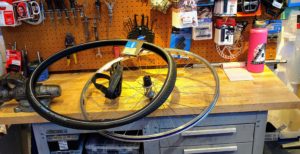
all together now
If you’re anything more than a casual weekend rider it’s well worthwhile to consider your choices in your wheels, tires, and (less so) tubes. These are the “shoes” of your bike, they’re they’re the part that touches the ground and keeps you upright and rolling. The lighter they are the faster you go, the stronger they are the longer you roll, and the cheaper they are the more beer and burritos you can buy! There are always trade offs when purchasing bike parts and our job is to guide you to figuring out your specific needs and finding a balance that works for you. Upcycles always has a selection of tires, tubes, and wheels that are perfect for most commuters and city riders.

